Bde Maka Ska
Bde Maka Ska (/bəˈdeɪ məˈkɑː skɑː/,[2] previously named Lake Calhoun, its former official designation)[3][4][5] is the largest lake in Minneapolis, Minnesota, United States, and part of the city's Chain of Lakes. Surrounded by city park land and circled by bike and walking trails, it is popular for many outdoor activities. The lake has an area of 401 acres (1.62 km2) and a maximum depth of 87 feet (27 m).
| Bde Maka Ska | |
|---|---|
| Lake Calhoun | |
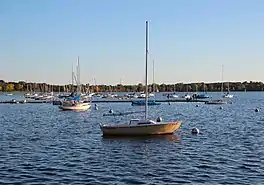 Boats on the lake in 2017 | |
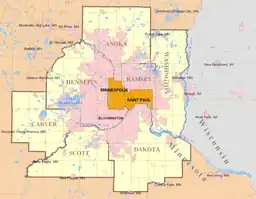 Bde Maka Ska | |
| Location | Minneapolis, Minnesota |
| Coordinates | 44°56′30″N 93°18′45″W |
| Lake type | Glacial |
| Native name | Bdé Makhá Ská (Dakota)[1] |
| Basin countries | United States |
| Surface area | 401 acres (1.62 km2) |
| Average depth | 30 ft (9.1 m) |
| Max. depth | 87 ft (27 m) |
Lake and surrounding area
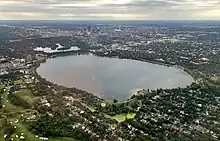
The lake is part of the Grand Rounds National Scenic Byway, connecting with Lake of the Isles on the northeast, Cedar Lake and Brownie Lake on the northwest, and Lake Harriet on the south. The Minneapolis Park and Recreation Board trail system has a 3.4-mile (5.5 km) trail around the lake for bicyclists and skaters and a 3.2-mile (5.1 km) trail around it for pedestrians. Both of these trails connect to the larger trail system via connections to Lake of the Isles and Lake Harriet. In addition, the Midtown Greenway Trail is located just north of the lake and Lake Street. The lake itself is popular for canoeing, kayaking, and windsurfing, and it has three swimming beaches.
.jpg.webp)
The three beaches are North Beach on the north side of the lake, 32nd Beach on the east, and Thomas Beach on the south. There is Bde Maka Ska Park and surrounding park land offers parking, picnicking, volleyball, and athletic fields. It is also home of sailing, hosting the Calhoun Yacht Club, the Minneapolis Sailing Center, as well as local high school teams and the University of St. Thomas Sailing Team.
%252C_1818_or_1824-after_1901.jpg.webp)
During 1829–1839, it was the site of the Bdewákhathuŋwaŋ Dakota agricultural village known as Ḣeyate Otuŋwe.[6] A plaque on the east side of the lake commemorates the mission station built by Samuel and Gideon Pond where they created the first alphabet for the Dakota language[7] at Cloudman's Village.[6] In 2019, the Bde Maka Ska Public Art Project was completed on the village site. On the west side is The Bakken, an old mansion with medicinal gardens and a library and museum devoted to medical electricity and the history of electromagnetism.[8] The Como-Harriet Streetcar Line operates between the lake and Lake Harriet.
Naming
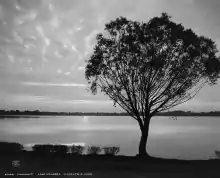
Historic names
The Dakota originally called the lake Mde Maka Ska (standardized Lakota/Dakota spelling Bdé Makhá Ská;[9][1] English approximation: Be-DAY Mah-KAH-Ska)[10] meaning 'Lake White Earth',[11] or 'Lake White Bank',[12] a name that probably was given by the Ioway who inhabited the area until the 16th century. Another Dakota name for the lake may have been Mde Med'oza, which was the name initially adopted by settlers, either as Lake Medoza or in translation as Loon Lake.[13] The Dakota also described it as Heyate Mde, meaning 'the set back lake'.[14]
Calhoun naming
The United States Secretary of War, John C. Calhoun, sent the Army to survey the area that would surround Fort Snelling in 1817. Calhoun had also authorized the construction of Fort Snelling, one of the earliest American settlements in the state. The surveyors named the water body "Lake Calhoun" in his honor,[15] and the Fort Snelling Military Reservation survey map of Lt. James L. Thompson in 1839 shows that name for the lake.[16]
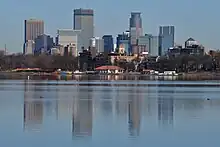
Calhoun–Bde Maka Ska naming dispute
Calhoun's legacy as a slaveowner and pro-slavery politician led critics to question whether he was the best person to be honored. In 2011 the Minneapolis Park and Recreation Board (MPRB) visited the issue. Their legal counsel concluded that the board could not legally change the name, as state law gives that power to the Commissioner of Natural Resources, and then only in the first 40 years after the name was designated. Following the Charleston church shooting in June 2015, a fresh drive to change the name started via an online petition and the Park Board indicated it would look into whether they could change the lake's name through state action.[17][18] At the time, the Minneapolis Star Tribune published an article quoting Calhoun's views on the black race:
The number of deaf and dumb, blind, idiots and insane of the Negroes in the States that have changed the ancient relations between the races [and are no longer slaves] is one out of every ninety-six; while in the States adhering to it [slavery], it is one out of every six hundred and sixty-one; being nearly six to one against the free blacks in the same state
as well as his actions in ordering the flogging of one his own slaves.[19] In fall 2015 the board added the Dakota name to signage below the official name.[1] In March 2016, an advisory group decided by majority vote to urge the MPRB to restore the lake's former name.[20] There was also a proposal to rename the lake for Senator Paul Wellstone, who is buried in nearby Lakewood Cemetery.[21]
In 2017, the Minneapolis Park Board voted unanimously to recommend changing the lake's name back to Bde Maka Ska[22] and the Hennepin County commissioners agreed.[23] In January 2018, the Minnesota Department of Natural Resources (DNR) made Bde Maka Ska the official name in Minnesota.[24][25] To change it at the federal level, the state submitted materials to the U.S. Board on Geographic Names,[26] which approved the change in June 2018.[27][28][2] Park signs around the lake use only the name Bde Maka Ska.[3][29]
On April 29, 2019, the Minnesota Court of Appeals reversed the decision of the DNR, holding that a name that had been in use more than 40 years could only be changed by the legislature.[30] The MPRB stated they would continue to keep the signage of Bde Maka Ska at the lake and Minneapolis Mayor Jacob Frey said, "I will continue to call Bde Maka Ska by its rightful name. That was the lake's name before people who look like me renamed it to honor a slavery apologist and – as far as I'm concerned – that is still its name today".[31] The DNR appealed the court decision, and also released a statement confirming that the federal Board on Geographic Names (BGN) had adopted Bde Maka Ska as the lake's official name.[31] Executive secretary of the U.S. Board on Geographic Names Lou Yost said, "State legislation (or court ruling) is not binding on the Federal Government. The name at the Federal level will remain Bde Maka Ska as was approved at the BGN's June 21, 2018 meeting".[32] The Minnesota Court of Appeals decision was appealed to the Minnesota Supreme Court, which heard oral argument November 13, 2019.[33] On May 13, 2020, the Minnesota Supreme Court ruled that the Minnesota Department of Natural Resources had the authority to rename Lake Calhoun as Bde Maka Ska, ruling that the law restricting renaming only applied to county boards, not to the DNR.[34]
Wildlife
.jpg.webp)
The lake contains black crappie, bluegill, bowfin, common carp, hybrid sunfish, largemouth bass, northern pike, pumpkinseed, tiger muskellunge, walleye, white sucker, and yellow perch. Some fish consumption guideline restrictions have been placed on the lake's bluegill, crappie, largemouth bass, northern pike, walleye, and white sucker due to mercury and perfluorooctanesulfonic acid contamination.[35]
In 1991, the then-Minnesota state record tiger muskellunge at 33 pounds 8 ounces (15.2 kg) was caught in the lake.[36] The Minneapolis Park and Recreation website lists the lake as one of the best in the city for ice fishing walleye, northern pike, and crappies.[37]
Zebra mussels, an aquatic invasive species, were found in the lake in 2018.[38]
References
- Greene, Britta (December 4, 2015). "How to say Lake Calhoun's Dakota name: 'Bde Maka Ska'". MPR News. Minnesota Public Radio. Archived from the original on December 7, 2015. Retrieved December 4, 2015.
The Minneapolis Park and Recreation Board added "Bde Maka Ska" to signs around Lake Calhoun
- Harlow, Tim (July 16, 2018). "Feds now recognize Lake Calhoun as Bde Maka Ska". Minneapolis Star Tribune. Archived from the original on 2018-08-25. Retrieved 2018-08-24.
- "Lake Calhoun officially recognized as Bde Maka Ska". Minneapolis Park & Recreation Board. January 29, 2018. Archived from the original on December 30, 2021. Retrieved January 5, 2022.
- Gillmer, Matt (January 29, 2018). "Lake Calhoun officially renamed Bde Maka Ska". Star Tribune. Archived from the original on May 9, 2021. Retrieved January 5, 2022.
- Marohn, Kirsti (October 8, 2018). "DNR confirms zebra mussels in Bde Maka Ska". MPR News. Archived from the original on January 1, 2022. Retrieved January 5, 2022.
- Beane, Katherine (2012). "Bde Maka Ska / Lake Calhoun, Minneapolis". In Westerman, Gwen; White, Bruce (eds.). Mni Sota Makoce: The Land of the Dakota. Saint Paul, MN: Minnesota Historical Society Press. ISBN 978-0-87351-869-7.
- "History of the Dakota Mission". Pond Dakota Historical Society. 2017. Archived from the original on 2017-10-28. Retrieved 2017-10-28.
- Sanders, Michael (2017). "ABOUT THE BAKKEN". The Bakken Museum. Archived from the original on 2017-12-01. Retrieved 2017-11-22.
- New Lakota Dictionary : Lakȟótiyapi-English, English-Lakȟótiyapi & incorporating the Dakota dialects of Yankton-Yanktonai & Santee-Sisseton. Bloomington: Lakota Language Consortium. 2008. ISBN 0-9761082-9-1. OCLC 181328003.
- Eldred, Sheila (June 23, 2016). "Renaming Lake Calhoun: Native American activist Syd Beane explains the Minneapolis lake's name change". Minnesota Monthly. Archived from the original on October 23, 2017. Retrieved October 23, 2017.
You learn how to pronounce it: Be-DAY Mah-KAH-Ska.
- Cairn, Rich; Cairn, Susan (2003). "History of Minnehaha Creek Watershed" (PDF). Minnehaha Creek Watershed District. p. 19. Archived from the original (PDF) on July 30, 2009. Retrieved August 6, 2009.
- "Lake Maka Ska has a nice historical ring to it". Star Tribune. Minneapolis. October 20, 2017. Archived from the original on October 23, 2017. Retrieved October 23, 2017.
- Brandt, Steve (October 12, 2015). "Dakota name for Calhoun probably originated with predecessor tribe". Star Tribune. Archived from the original on May 13, 2016. Retrieved May 11, 2016.
- Myrbo, Amy; Murphy, Marylee; Stanley, Valerie (2011). "The Minneapolis Chain of Lakes by bicycle: Glacial history, human modifications, and paleolimnology of an urban natural environment". In Miller, James D.; Hudak, George J.; Wittkop, Chad; McLaughlin, Patrick I. (eds.). Archean to Anthropocene: Field Guides to the Geology of the Mid-Continent of North America. GSA Field Guides. Vol. 24. Boulder, Colorado: The Geological Society of America. pp. 425–437. doi:10.1130/2011.0024(20). ISBN 978-0-8137-0024-3.
Lake Calhoun, first known by Native Americans as Lake Medoza ("Lake of the Loons"), Mde Maka Ska ("Lake of the White Earth"), or Heyate Mde ("Lake Set Back from the River")...
- Keating, William H. (1824). Narrative of an expedition to the source of St. Peter's River, Lake Winnepeek, Lake of the Woods, &c., &c. : performed in the year 1823, by order of the Hon. J.C. Calhoun, secretary of war, under the command of Stephen H. Long, major U.S.T.E. Philadelphia: H.C. Carey & I. Lea. p. 303. OCLC 77170807.
- Johnson, Frederick L. (2009). Richfield: Minnesota's Oldest Suburb. Richfield, Minnesota: Richfield Historical Society Press. p. 2. ISBN 9781605856360.
- Brandt, Steve (June 23, 2015). "Lake Calhoun name change gets another look in Minneapolis". Star Tribune. Archived from the original on June 25, 2015. Retrieved June 25, 2015.
- Brandt, Steve (June 24, 2015). "Minneapolis Park Board gives fresh look at renaming Lake Calhoun after South Carolina shootings". Star Tribune. Archived from the original on June 25, 2015. Retrieved June 25, 2015.
- Furst, Randy, "John C. Calhoun, namesake of a Minneapolis lake, beat his slaves and trumpeted slavery" Archived 2019-06-09 at the Wayback Machine, Minneapolis Star Tribune, July 11, 2015.
- Steve Brandt (March 24, 2016). "Lakes panel urges restoring Bde Maka Ska name for Lake Calhoun". StarTribune. Archived from the original on March 25, 2016. Retrieved March 25, 2016.
- Thomas, Dylan (October 11, 2017). "New petition seeks to rename Lake Calhoun for Wellstone". Southwest Journal. Archived from the original on October 24, 2017. Retrieved October 23, 2017.
- Faiza Mahamud (May 3, 2017). "Minneapolis Park Board votes to change Lake Calhoun name to Bde Maka Ska". StarTribune.
- Nate Gotlieb (November 22, 2017). "Bde Maka Ska recommended by County Board". Southwest Journal. Minnesota Premier Publications. Archived from the original on November 29, 2017. Retrieved November 23, 2017.
The Hennepin County Board on Nov. 21 voted to recommend changing the name of Lake Calhoun to Bde Maka Ska, which means "Lake White Earth" in Dakota.
- Minnesota Department of Natural Resources (January 18, 2018). "Re: The Proposed Renaming of Lake Calhoun, Minnesota Public Water No. 27-31 in Hennepin County, Minnesota to Bde Maka Ska" (PDF). Names of Geographic Features Order. Archived (PDF) from the original on February 21, 2018. Retrieved February 20, 2018.
- Chanen, David (January 19, 2018). "The state officially changes Lake Calhoun to Bde Maka Ska". Star Tribune. Minneapolis. Archived from the original on January 25, 2018. Retrieved June 1, 2018.
It's official, at least in Minnesota: Lake Calhoun, the biggest lake in Minneapolis, will now go by its original Dakota name, Bde Maka Ska.
- Minnesota Department of Natural Resources (January 18, 2018). "State of Minnesota approves Lake Calhoun name change to Bde Maka Ska". News Release. Archived from the original on February 22, 2018. Retrieved January 27, 2018.
- "Feature Detail Report for: Bde Maka Ska". Geographic Names Information System. United States Geological Survey. July 15, 2018. Archived from the original on July 16, 2018. Retrieved July 15, 2018.
- Staff (July 15, 2018). "Federal government now recognizes Minneapolis lake as Bde Maka Ska". MPR News. Minnesota Public Radio. Archived from the original on July 16, 2018. Retrieved July 16, 2018.
- Du, Susan (January 30, 2018). "It's final: Lake Calhoun is now Bde Maka Ska, named in honor of original Minnesotans". City Pages. Minneapolis. Archived from the original on June 20, 2018. Retrieved June 19, 2018.
Minneapolis Parks and Rec has torn down the old Lake Calhoun signs and drilled in new ones bearing Bde Maka Ska.
- A18-1007 (April 29, 2019). "Save Lake Calhoun, Appellant, vs. Sarah Strommen, et al., Respondents" (PDF). State of Minnesota Court of Appeals. Archived (PDF) from the original on May 2, 2019. Retrieved April 29, 2019.
- "Mayor, Park Board push back on ruling changing Bde Maka Ska to Lake Calhoun". KARE 11. April 29, 2019. Retrieved April 30, 2019.
- "Minneapolis Park and Recreation Board president responds to ruling on Lake Calhoun/Bde Maka Ska name change". KSTP-TV. April 29, 2019. Archived from the original on April 30, 2019. Retrieved April 30, 2019.
- "Supreme Court to hear Bde Maka Ska case". Archived from the original on 15 December 2019. Retrieved 5 April 2020.
- Otarola, Miguel (May 13, 2020). "State had the authority to rename Lake Calhoun as Bde Maka Ska, high court rules". Star Tribune. Archived from the original on May 13, 2020. Retrieved May 13, 2020.
- "Lake information report: Minnesota DNR". MN DNR. MN DNR. 2005-07-25. Archived from the original on 2004-08-30. Retrieved 2005-08-30.
- Ron Hustvedt Jr. "Taking On The Metro's Tiger Muskies". Primedia Enthusiast Magazine. Archived from the original on 2005-10-26.
- "Ice Fishing". Minneapolis Park and Recreation Board. 2017. Archived from the original on 2018-01-31. Retrieved 2017-10-23.
- "DNR says invasive zebra mussels found in Minneapolis' Bde Maka Ska". Pioneer Press. St. Paul, Minnesota. October 8, 2018. Archived from the original on December 7, 2018. Retrieved December 6, 2018.